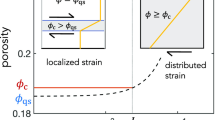Abstract
A KEY component of a continuum-mechanical description of a sand pile (viewed as an assembly of hard particles in frictional contact) is the requirement of stress continuity—the forces acting on a small element of material must balance. But an additional physical postulate is required to close the equations. Standard continuum approaches postulate that the material is everywhere just at the point of slip failure1,2. But these approaches have been unable to explain a startling experimental observation3—that the weight exerted by a conical sand pile on a surface has a minimum, not a maximum, below the apex. Here we propose a new closure, which embodies an intuitive model of arching4,5 within a fully consistent continuum theory. Our assumption is that the principal stress axes have a fixed angle of inclination to the vertical. In two dimensions, this is sufficient to close the equations. In three dimensions, a second closure relation is required, but our results are relatively insensitive to the choice made. Our model, which contains no adjustable parameters, can account for the vertical stress distribution in real sand piles. This supports the idea that stresses propagate within a granular medium according to local rules that depend on its construction history.
Similar content being viewed by others
References
Nedderman, R. M. Statics and Kinematics of Granular Materials (Cambridge Univ. Press, 1992).
Sokolovskii, V. V. Statics of Granular Materials (Pergamon, Oxford, 1965).
Smid, J. & Novosad, J. in Proc. of 1981 Powtech. Conf., Ind. Chem. Eng. Symp. 63, D3V 1–12 (1981).
Edwards, S. F. & Oakeshott, R. B. Physica D 38, 88–93 (1989).
Edwards, S. F. & Mounfield, C. C. Physica A 226, 1–33 (1996).
Bouchaud, J.-P., Cates, M. E. & Claudin, P. J. Physique I 5, 639–656 (1995).
Bouchaud, J.-P., Cates, M. E., Prakash, J. R. & Edwards, S. F. Phys. Rev. Lett. 74, 1982–1985 (1995).
Brown, R. L. & Richard, J. C. Principles of Powder Mechanics (Pergamon, New York, 1966).
Jokati, T. & Moriyama, R. J. Soc. Powder Technol. Jpn 60, 184–189 (1979).
Bagster, D. F. & Kirk, R. J. Powder Bulk Solids Tech. 1, 19–24 (1985).
Hong, D. C. Phys. Rev. E. 47, 760–762 (1993).
Huntley, J. Phys. Rev. E. 48, 4099–4111 (1993).
Liffman, K., Chan, D. Y. & Hughes, B. D. Powder Technol. 78, 263–271 (1994).
Trollope, D. H. in Rock Mechanics in Engineering Practice (eds Stagg, K. G. & Zienkiewicz, O. C.) 275–320 (Wiley, New York, 1968).
Trollope, D. H. & Burman, B. C. Geotechnique 30, 137–157 (1980).
Claudin, P. thesis, Univ. Cambridge (1989).
C. H. Liu et al. Science 269, 513–515 (1995).
Wood, D. M. Soil Behaviour and Critical State Soil Mechanics (Cambridge Univ. Press, 1990).
Author information
Authors and Affiliations
Rights and permissions
About this article
Cite this article
Wittmer, J., Claudin, P., Cates, M. et al. An explanation for the central stress minimum in sand piles. Nature 382, 336–338 (1996). https://doi.org/10.1038/382336a0
Received:
Accepted:
Issue Date:
DOI: https://doi.org/10.1038/382336a0
- Springer Nature Limited
This article is cited by
-
The experiment and analysis of the repose angle and the stress arch-caused stress dip of the sandpile
Granular Matter (2022)
-
The experiment and analysis of the stress dip underneath the granular silo
Granular Matter (2022)
-
Micro-scale interactions between Arabidopsis root hairs and soil particles influence soil erosion
Communications Biology (2020)
-
Experimental realization of incipient active failure in sand heap by seismic loading
Granular Matter (2020)
-
The unusual problem of upscaling isostaticity theory for granular matter
Granular Matter (2020)





